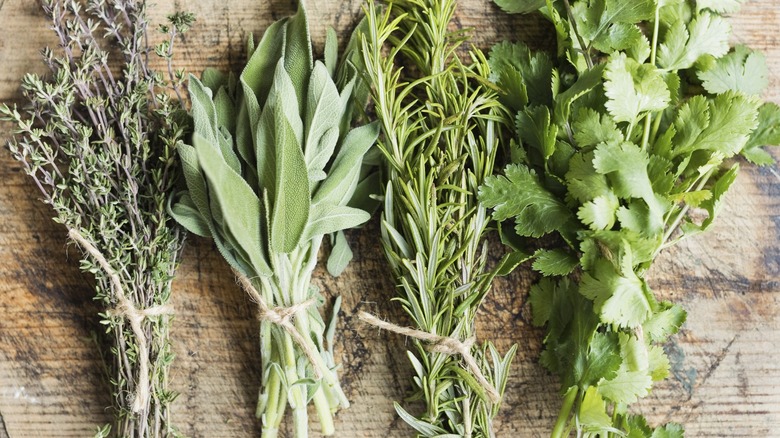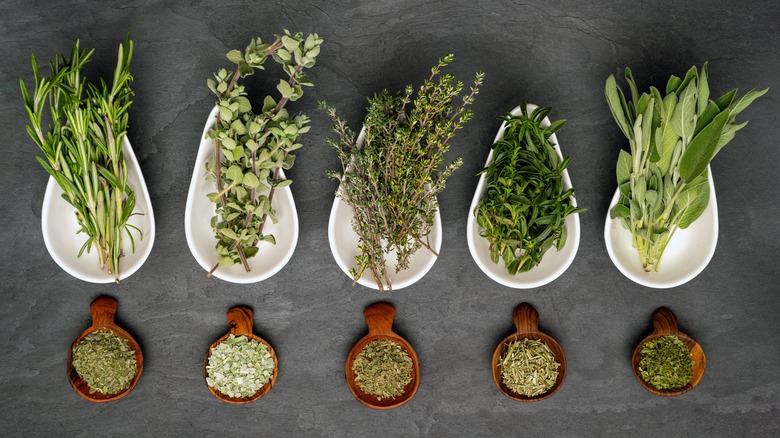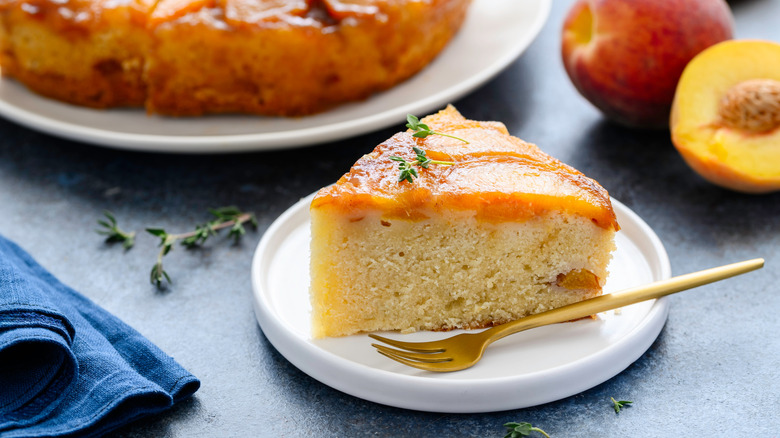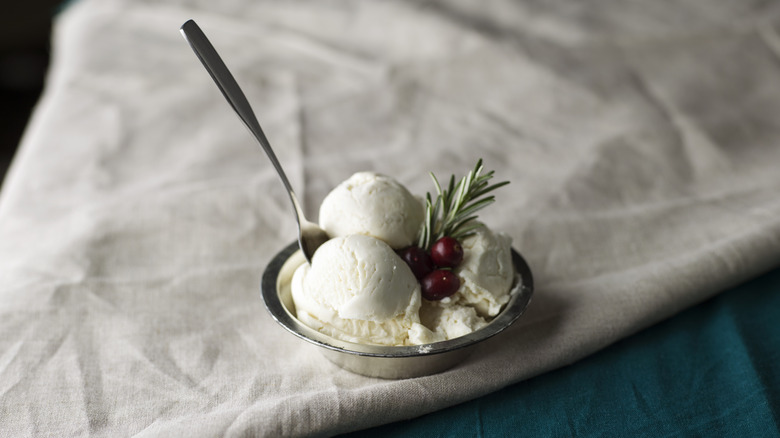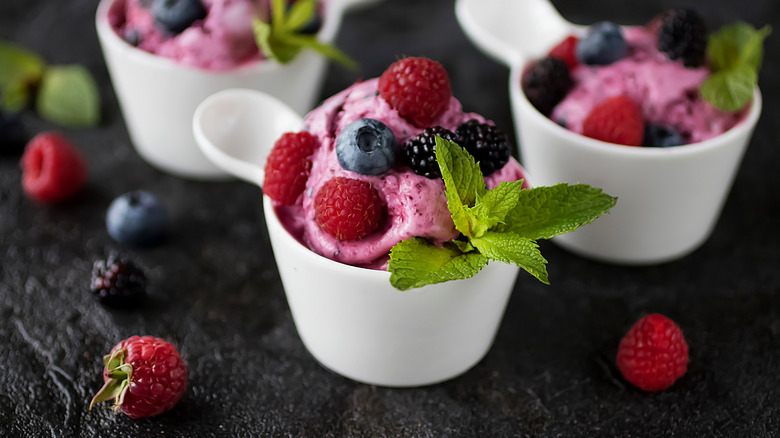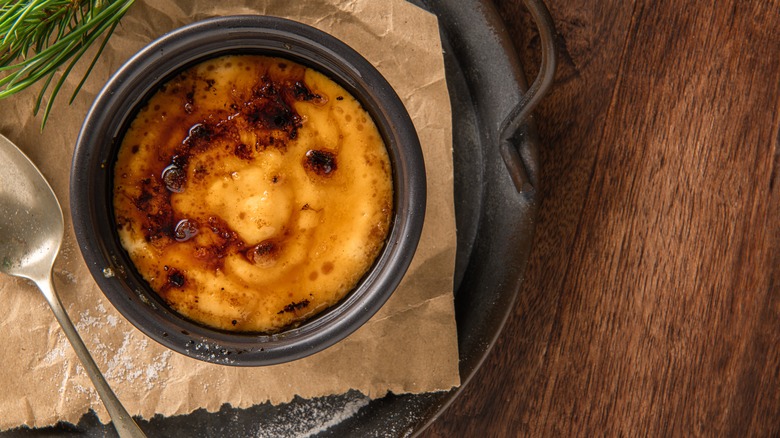Herbs Aren't Just For Savory Meals
Did you buy a basil plant from Trader Joe's over the summer and quickly discover you don't eat nearly enough pesto for the rate at which your plant produces leaves? We've been there. The solution? Be a little more creative with how you use your herbs — savory isn't the only answer.
One of the most important techniques in cooking, but one that's sometimes hard to internalize, is the fact that complementary ingredients are necessary to bring out depth of flavor. You don't just add sugar to make chocolate pop in cookies — you add salt. Similarly, sweetness can be balanced with sourness or acidity (think lemon bars). So, it makes some sense, then, that adding a little basil or thyme can bring your dessert to the next level. These unusual pairings, when balanced properly, will make your cookies or cobblers taste as fancy as if they were straight from a French patisserie.
Worried you don't have the where-with-all to invent or find that perfect balance? Ana De Sa Martins, the Executive Pastry Chef of Stubborn Seed, gave us some pro tips. The most essential one, Martins says, is "to not be afraid to experiment ... it's just food at the end of the day. Start with a little amount and increment as you taste."
Fresh or dried? Garnished or infused?
When you start to think about all the possibilities of herb and dessert combos, it might feel overwhelming. One question begets another — do you chop your herbs? Or infuse them into your dessert? Should you use fresh or dried? There's no hard and fast rules, but Ana De Sa Martins' preference is to use herb-infused components like syrups, milk, or cream to evenly distribute flavor and better control the strength of the herby elements. Infusion often involves heating the liquid ingredient, adding the herb, and simmering it for a few minutes so the flavor can seep in, and then removing the herb from the pot and cooling it down.
As for the fresh versus dried debate, you can probably guess her answer: "I will always prefer to use fresh herbs because of the touch of freshness and fragrant notes it adds to desserts, which, in my opinion, you can't really taste with dried herbs." Still, Martins says there are times where using dried herbs is the best option, such as in cookie dough, pie crust, or cake batter. Ultimately, it's going to come down to which dessert you're making and what you have on hand. But if you're feeling baker's block when it comes to combo creativity, Martins has a few suggestions for the perfect pairings.
Thyme and peach cobbler
Got a lot of thyme on your hands? Try making an upgraded peach cobbler, crumble, or crisp. You heard it here first, folks: Ana De Sa Martins says thyme goes excellently with any stone fruit, be it peaches, apricots, or nectarines. "Its earthy and lemony flavor complements certain ingredients like honey and citrus," she explains. To make it pop even more, up the sweetness by honey-roasting your peaches in your oven.
You have a couple of options for how to do this — one, you could simply mix a couple tablespoons of fresh thyme leaves into your peach (or apricot, or nectarine) filling. Two, you could mix dried herbs directly into your pie crust for a buttery and slightly peppery shell to your perfectly sweet pie.
Rosemary and ice cream
If there's one thing we take into 2025, maybe it should be a more adventurous spirit when it comes to our ice cream flavors. From cheese ice cream combos (yes, you heard us right) to herby, savory-sweet, complex, and creamy flavors, ice cream is the perfect canvas to play around with. That's why Ana De Sa Martins' next tip involves combining a sprig of rosemary with vanilla, pistachio, or chocolate ice cream.
"When used correctly, rosemary adds a piney and earthy flavor to desserts, and it could be an elegant final touch to a dessert," Martins says. For this dessert, though, she doesn't recommend going for a direct sprinkle. Instead, try making an infused simple syrup with honey or olive oil, simmering your rosemary in the liquid, removing it after a few minutes, and then topping your bowl with the sweet and woodsy syrup before sprinkling a pinch of sea salt on top. If you're struggling to de-stem your rosemary, try using a box grater to de-stem with no stress.
Basil and sorbet
Staying on the ice cream theme but mixing it up to be open for lactose-intolerant cooks or guests, let's talk about sorbet. This vegan-friendly dessert is made from ice, sugar syrup, and either fruit puree or fruit juice, making it closer kin to shaved ice than ice cream, really. Still, its smooth texture combined with fresh, fruity flavors makes it feel like a true treat, and can bring a touch of summer to your day even when summer is a distant memory. To add basil to your sorbet, simply mix a basil simple syrup into your fruit puree. As Ana De Sa Martins says, "Its subtle aromatic quality adds freshness and depth."
As for the exact flavor combos, basil with strawberry or basil with citrus fruit like lemon or orange are classics, but there are ways to make this feel fresh and exciting. For example, try pairing basil with a mandarin sorbet, or serving it in a chilled cup made from half a lemon.
Tarragon and crème brûlée
To conclude our journey through the world of herb desserts, we're suggesting something a little more out-of-the-box — but luckily, the infusion method is the same. Tarragon is known for its anise-like (aka licorice) flavor, while remaining light enough that even a true licorice-hater can still enjoy it. Ana De Sa Martins' suggestion for harnessing this unique herb? Pairing it with a creamy, caramelized crème brûlée.
Crème brûlée, a classic French dessert, is simultaneously simple and sophisticated, with a strong vanilla backdrop made more interesting by its crisp top layer of torched sugar. Infusing tarragon into the heavy cream can beautifully cut the brûlée's creaminess, and adding sugary, macerated berries on top can make this combo shine even more. Dried tarragon can also be swapped with basil in a pinch for a somewhat equivalent flavor profile, maintaining the peppery, aromatic tint while being an ingredient more commonly found in most peoples' spice cabinets.
